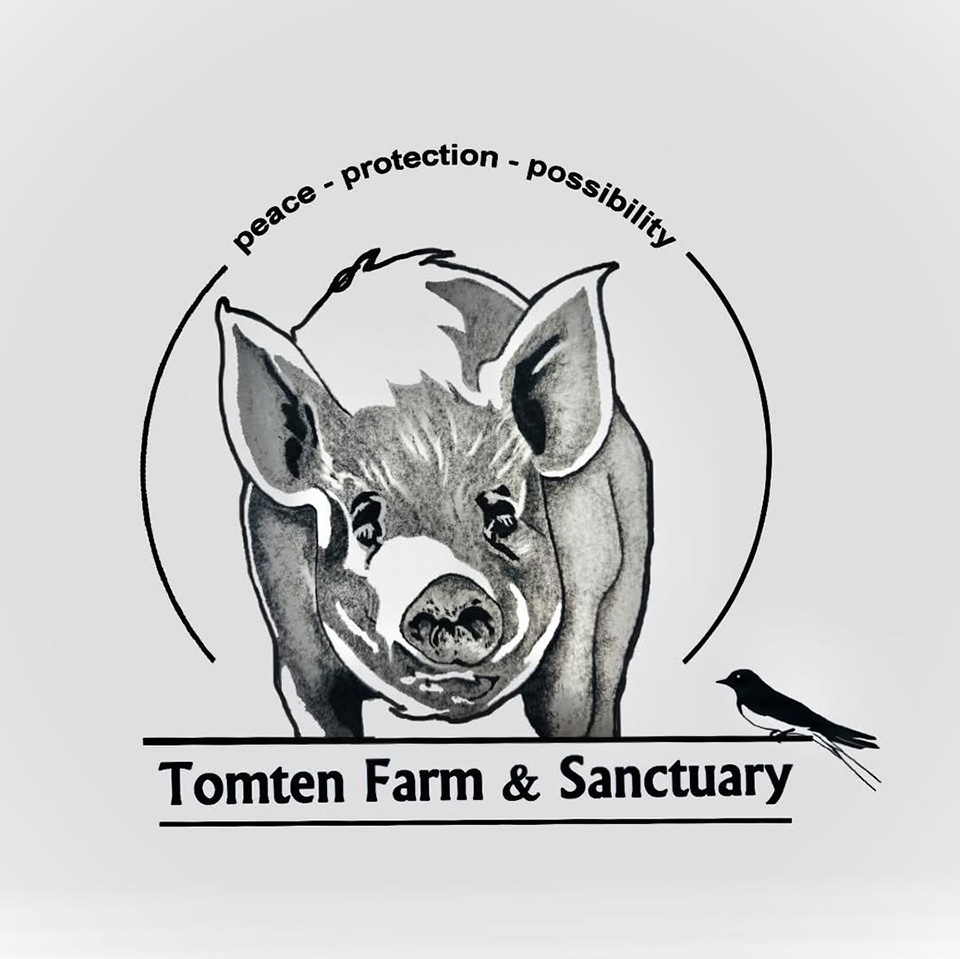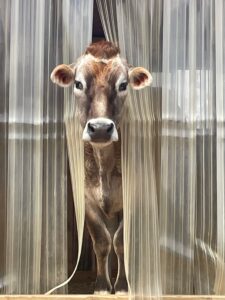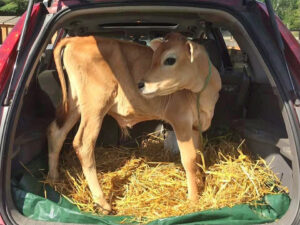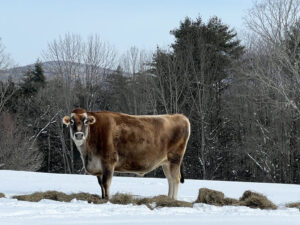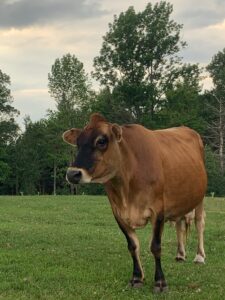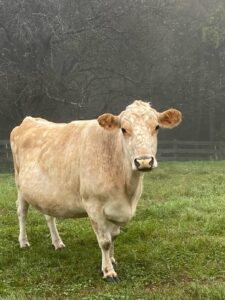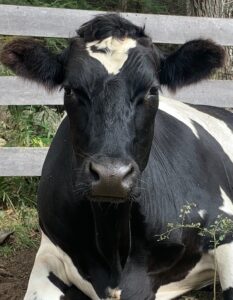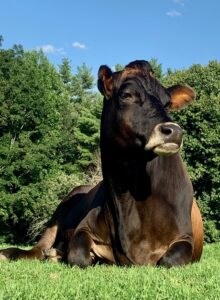Meet the Cows
We always said we would rescue until the cows come home. Well, now they have.
And we will keep on rescuing until we bring as many home as we realistically can.
Click on image to read individual stories.
Meet and Greet. Gideon Moo
We had always wanted to rescue a cow at Tomten but had decided to wait until we completed our move from Massachusetts and got through our first year here in New Hampshire. But, the universe works in interesting ways and so our very first Moo joined us just a few months after our arrival, on August 3, 2016. It was exactly one year from the purchase date of this beautiful farm and only three months after our move.
He, like several of our rescues, found us. This time through casual conversation at a farm stand with a stranger who turned out to be a dairy farmer. When I told him of our desire to step up for a jersey bull calf the following Spring, he mentioned that he had one then, a late arrival that for some reason he had not yet shipped but WAS scheduled to go that Thursday. I couldn’t believe it but, responsibly declined knowing that neither the farm nor our accounts were ready for a bull calf. Yet, I took the farmer’s number anyway because one never knows when the impossible becomes possible and sometimes things just work out. Never close the door on possibility.
While it doesn't always work this way, in a perfect world, dialogue with small farmers who are open to responsible rescue should be valued and rescues, in turn, should be open-minded and non-prejudicial. We do our best but knowing of that little life in need gnawed at me so, after going home and reaching out to the Tomten Board, I called the farmer for details, cautiously considering the possibility. Wouldn’t you know, the calf in discussion was the same hutched, brown-eyed bull calf that I had slowed down to admire from the road just days before? Perhaps he was destined to come to Tomten Farm and Sanctuary. We just couldn't allow him to ship to auction to be sold for slaughter for pennies on the pound. His fate was sealed; somehow, we would find a way to offer him peace, protection and possibility.
There are over nine-million milk cows (note: this number does not include "beef" cows) in the United states and thousands of bull calves in need born on any given day throughout the country. Each one beautiful, deserving and, sadly, considered a by-product of the dairy industry. Since many people are unaware that there is no milk produced without cows being bred (most via artificial insemination) and giving birth to calves, many are also unaware that most bull calves are hidden casualties of the dairy industry. To create a high yield and be profitable, dairy cows are routinely bred yearly. Most male calves lose their lives within days of being born while veal calves are raised for 18-20 weeks before they are shipped to slaughter and still others, are occasionally raised for the year before being sent to be "beefed". None come close to living out their life expectancy of twenty plus years.
It was unusual that this little calf, at a few weeks of age had not already been picked up. He was one of many who would be collected on the weekly “beef run” that would place him first, in a holding pen with other calves and cull cows and then, via another trailer enroute to auction, where he would find himself surrounded by a hundred others like him, scared, hungry, and hours away from a horrible fate if he even made it through the sale. Perhaps, the universe had purposely stalled his ship date as she plotted his route to us. It sure felt that way and we were listening. The farmer who owned him kindly agreed to hold him for one week, giving us a chance to fundraise for part of the expenses we would need to support him after his rescue. Together with people like you, those who support our journey, we achieved our goal and together we welcomed our first ever bovine to Tomten Farm and Sanctuary. It was an instant love affair!
But Gideon did not arrive in traditional trailer style. When I was called into work, our Vice President, Laima and our intern, Aileen went to get him in their car. What a sight he must have been to passers by – a bull calf riding in the hatch of a little Honda SUV! Today, he is several hundred pounds too big for that same ride, full grown and beautiful.
If you know the Bible story of Gideon you know he was called upon to save the people and here, in what I consider God’s country, our Gideon led the way for us to save more bovines with our Gideon’s Gift Cow Rescue and Adoption Initiative. This once little and now giant life, a by-product of the dairy industry, has led to the rescue of ten additional cows, five who have been adopted, and five who reside beside him.
But his impact has not stopped there. He has welcomed hundreds of visitors and reminded many of the thousands of lives lost just like him (34 million bovines were killed, cut and packaged at American meatpacking plants last year alone.) May he encourage all who meet him to consume with compassion. Perhaps, they will go dairy-free but if one is not quite ready to switch, a simple “no” to factory farm products, or even a day without dairy would make a difference. Whatever you do in his honor, it matters to him and those lost every day who aren’t so lucky. May kindness lead our choices and our love of animals guide the way.
Thank you for helping us give him the gift of life and dreams come true. We hope he will be with us for many, many years.
Gideon Moo
Meet and Greet. Marilyn MOOnroe.
She used to be Tag #733 but almost four years ago she became Marilyn MOOnroe. No, she is not blond, but THIS Marilyn will always be a star in our book. And she'll never ever be "just a number" again.
Destined for a local slaughterhouse, this beautiful girl was the first culled dairy cow we ever rescued in Tomten Farm and Sanctuary's Cow Rescue Initiative program and we were over the moooo-n with happiness to welcome her to peace, protection and possibility. Gideon, our first ever rescued bull-calf (now steer) was as excited as we were and soon after arrival we knew that this hard working girl would forever be part of Tomten Farm and Sanctuary.
We were told she was just about ten years old at the time of her rescue. Reaching that age is quite an accomplishment for a dairy cow. Most are shipped by the time they are just five years old to make room for younger animals, those who can produce a few more gallons of milk in an industry where every gallon and every dollar count. But luckily for her, she was part of a small, Jersey herd with a farmer who often kept the most productive gals for years past their prime and, he was willing to work with us to save her life.
At ten years old, she had been a production cow for over eight years. If we simplify that and break it down, that means being milked just shy of 300 days a year (she got 60 days pre-maternity leave before giving birth). With an average Jersey production of five gallons a day, she produced a lifetime total of 12,000 gallons of milk at a cost of one calf per year. That equals 6000 pounds of butter or 4000 gallons of ice cream or 1500 gallons of cream. Think about that, an entire life of milking equals just 1500 gallons of cream and not once was she able to keep her calf.
While false pregnancy in cows is not really a thing, this lovely girl somehow bags up each Spring, full of milk for a calf that is not there. At first, we thought it was a response to the calves we had rescued her first two Spring seasons with us, but it is a pattern she has continued every year and for us a reminder of the little lives she lost. It is another reminder to do more, be more and give more to animals in need.
The Spring of 2020, she gave us quite a scare when she once again came into milk. To our surprise, she quickly developed a scary case of mastitis. If you’re familiar with lactating animals you know that can be a very big deal. In fact, depending on the kind (there are more than 15 different types of bacteria that can cause it) it can actually be life threatening in cows.
We worked with our amazing vet, sent samples to the lab and as it turns out the infection was caused from contaminated milking equipment in her past. Crazy, right? In basic terms, the infection was caused by a bacteria she had been carrying for years called staph aureus. It had been unformed micro abscesses which had been dormant but a pustule had ruptured spreading infection throughout the udder and into individual teats.
In addition to dipping her sore teats, we injected meds in all four daily and thankfully, we were able to control the infection although it can never be eliminated. Oh no! Each Spring and Summer we watch her closely for signs of infection and dip her teats as a daily preventative and we keep our fingers crossed that the infection does not recur. In rescue, there is often so much more than meets the eye and we are always learning. We hope through Tomten you are too.
Here at Tomten we believe that everyone is on their own journey and draws their own lines. Change happens by choice when each individual is ready. Perhaps though, in honor of Marilyn and those like her, you might consider one small effort. According to the International Dairy Foods Association (IDFA), in 2020, the average American consumed 655 pounds of dairy. Holy cow! We can do better than that!
Perhaps it is a day without dairy, a permanent switch to black coffee or a pledge to try one dairy alternative (of which there are more and more good ones in your grocery cases every day) at a time. I hope you can do more. No act of kindness is insignificant and every decision we make has an impact on lives like Marilyn's and all her sister cows who are still on the production treadmills across America. We can all become more aware, do better and be kinder and most often that is a personal process. I know it was for me, Jenifer, and I'm never looking back.
Thank you for being on her journey
Marilyn MOOnroe
Meet and Greet. Greta GarMOO.
In May of 2017, at seven years old, dairy cow #100, found herself in trouble. She had spent her entire life giving, had produced approximately 50,000 pounds of milk (translation, over 5500 gallons) and had been the mother of four babies, all of whom long ago removed from her side. If males, they had sadly already passed, by-products/casualties of the industry or if girls, they had become the next generation to give and replace older cows like her. Yet, even with her many contributions, that spring she was close to the end of the line.
Residing at one of the few small dairy farms left in New England she lived a life that in many ways, beat dairy statistics. She had turnout every day the weather allowed, pasture each Spring, Summer and Fall and lived with a herd that had lower than normal turnover as the farm frequently kept cows well past the average factory farm shipping age of five. Yet, she remained a dairy cow, and in her case, for multiple reasons including a non-functioning teat, it seemed the age of seven was to be her last year. It had been decided that with better, younger options available and her poor udder conformation, she was an unlikely choice to be bred again. Without that, there would eventually be no milk and for profitability reasons, she was determined better off dead.
Even at her best, her milk production had gradually been declining and she had no longer been contributing to the farm that supported her. In fact, she was barely supporting herself and the struggling dairy farm that owned her quite simply, could not afford to keep her. With several heifers ready to take her place in the barn and two contributing “fresh” cows (those who had just given birth) just about ready to return to the milking line, without our immediate assistance the handwriting was on the wall. Her plans were already made. She was very close to being picked up by a livestock dealer, shipped to a local auction, and most likely bought by the large commercial slaughterhouse in Pennsylvania, destined to be processed, becoming the hamburger that sizzles on the grills at many cookouts. It was the price she would pay for America's voracious appetite for red meat. Did you know that most hamburger is made from dairy cow meat?
Thankfully, we have a history of making sure it is never, "us against them" and we had a chance to save her. Together we once again rallied, preventing this “spent production cow” from being one of the thousands every day that end their life alone and scared in a slaughter chute. In May 2017 we purchased her for the same price per pound amount that the farmer would have gotten from slaughter and she arrived at Tomten Farm and Sanctuary. Together, we saved her life. No longer was she #100 but thanks to your name suggestions, she became Greta GarMOO. Here, for the rest of her days, she will stay, enjoying peace, protection and possibility beside her best friend Marilyn MOOnroe.
We joke that these two cows who had come from the same farm saw one another and exclaimed "Oh my goodness, you are here too? Look at this place, dreams really do come true!". Marilyn and Greta are rarely far apart and we hope they have found happiness that will embrace them for the rest of their days. While both are in good health, Greta began to lose her pigment this year and quite simply, her black points just disappeared. After multiple tests, she has been diagnosed with Vitiligo and while her lab reports are normal she remains under our watchful eye with hopes that she remains healthy for many more years. After all, it does not matter how you look but how you feel that counts and we think she is beautiful either way.
Interestingly, we share a bit of food for thought. There are less than 100 dairy farms left in New Hampshire. Fifty years ago, in 1970 there were 829 commercial dairy farms. In 2020 that number dropped to just 95. At the same time, as smaller family farms disappear throughout the United States, larger, CAFO (concentrated animal feeding operations) farms are growing at a rapid pace. In 2003 there were 70,375 farms in the United States producing milk commercially. By the end of 2020, there were just 31,657. Yet in 2021 the total NUMBER of dairy cows has hit an all-time high. Where are they? Not on the beautiful rolling green pastures you used to be able to see while driving through New England, that's for sure. Many of those former farm properties are now either residential housing/condo developments or retail malls. There may be less visibility but the need for kinder ways is still there.
While we cannot save them all, for the animals we rescue we are everything and they in turn allow us to work side by side, humans and animals alike, to raise awareness for others. Today, as we do every day, we whisper words of gratitude to all who helped us save her, all who help us continue to support her and to her TAdopter, Karen whose initial contribution toward a percentage of her lifetime care, helped make it possible for her to remain at Tomten Farm and Sanctuary.
Greta GarMOO
Meet and Greet. Humphrey MOOgart.
This four-year old, beautiful Jersey/Holstein Cross, was the 9th bovine saved by Tomten Farm and Sanctuary (he and four others are still here with us today and four have been adopted).
We met him in late December of 2017 when he was just days old, already separated from his Mom. Tied by a hay string to the wall of the dairy barn, he was destined for imminent slaughter. He was so small with a perfect little heart on his head and if we could have, we would have scooped him up and brought him here right then. But there were plans to be made, funds to be raised and questions to be answered. As it turned out, while we said yes right away, it was determined that it was best that he temporarily stayed where he was and received the benefits of milk, lots of it. Yes, we could have used a powdered version but the real thing was critical to his health and development and so, after carefully weighing the pros and the cons, we decided to wait.
Thankfully, he had already received his mother's colostrum, the first milk she produced after giving birth. Essential to provide calves with their initial protection, colostrum helps the calf transition to actual milk and provides passive immunity that helps keep him healthy. It is something many bull calves are deprived of before they are shipped and 80% do not survive without it. That was not the only gift though. The farmer was willing to keep him there if we paid for the milk that the calf would drink which otherwise would have been collected and transported to the processing factory.
Despite our wish to welcome our newest rescue right away, we took the advice we were given that it was in his best interest to stay where he was and receive as much fresh milk as possible as he learned to eat hay and starter grain. Rumen (the largest stomach compartment of a cow) development is incredibly important and takes a bit of time before a calf can wean off a total milk diet successfully. So we waited and worried and waited and worried as he moved from a tie on the wall to a calf hutch outside. We tried not to wear out our welcome at the barn, but we did drop off extra bedding in the cold, visiting weekly until he was ready to go. Yes, it was a hard call but we are so glad we did what we did and that the farmer was willing to work with us so we could.
When he finally arrived at Tomten, this sweet little calf who wore his heart on his forehead, was so tiny that he lived with the sheep and goats, but he continued to quickly grow and before we knew it he was ready to meet the moos.
Like Gideon, this bull-calf was considered a by-product of the dairy industry but unlike Gideon, he was half Holstein (where his black and white coloration comes from) and half Jersey. Holsteins are the largest of the dairy breeds (and produce the most milk) and Jerseys (Gideon and all our other Moos) are the smallest (and known for their rich milk). Both make the list of the top dairy breeds, in fact they are numbers one (Holstein) and two (Jerseys). Breed and potential for milk production really doesn't matter though if you are born a male. Male calves are always at risk though a lucky few may be chosen to be trained to be oxen, popular as draft animals in years past but mostly seen as 4-H projects now. At first, we had no intention of welcoming him to Sanctuary. Our plan for him, like that we had for some of those who had arrived here before him, was to find him the perfect home via our Cow Rescue and Adoption Initiative and then welcome another into the protection of Tomten Farm and Sanctuary. Ahh the best laid plans. The universe had her own idea.
While we waited for the right adopter, he had been vaccinated, castrated and de-budded (de-horned); all necessary procedures that ensured everyone's safety, his, ours and the other rescues on the farm. We even named him: Humphrey MOOgart, a name created by you, our followers.
We waited for the perfect home but not surprisingly it never came. Few people, after all, want a large cow (steer) who doesn't produce milk for a pet. It's a challenging thing to adopt a young moo and the longer he stayed, the more he grew and the more his relationships, especially with Gideon, did too. While we encouraged interested parties to make their mooove to adopt this special youngster soon, eventually, we simply gave up and gave in to the friendship of these two special boys.
Tomten Farm and Sanctuary would not be the same without this very big steer and we love the opportunity to share his story with you. We were fortunate enough to be welcomed at the barn from which he was saved and to welcome him in January of 2018. We hope that Humphrey will be here with us for many, many years to come, sharing his story and hopefully raising awareness of others like him. They are the true price that is paid for dairy, and it is a dear cost indeed. Simply look at this sweet face and know he would not grace the earth today if it were not for the love and support of people like you.
Humphrey MOOgart
Meet and Greet. Ripley Believe It or Not.
One ear tag said "Ripley" and the other, older one, said "Riley."
No matter how you looked at, we decided that we could not change her names but determined that we should probably narrow it down to one.
Should she be "Ripley," she was headed to her believe it or not but, should she be "Riley," she was headed to the life of Riley as her fortune and fate once again changed. Here at Tomten she became known as Ripley Believeitornot and since day one we have tried to wow her with the magic and miracles of dreams come true.
At the time of her rescue, small dairy farms throughout the country were closing their doors at an alarming rate. Both farmers and cows alike found themselves in trouble. The "get big or go bust" mentality had forever changed the face of dairy, agriculture, the future of farming and indeed, it had changed the landscape of many farming communities, including ours here in Haverhill, New Hampshire. That change impacts all of us no matter where we are, what we stand for and whether we realize it or not. It certainly impacted Ripley and her herd.
Here in New England, there are less than 1500 dairy farms left and that number is dropping every year. It is just not sustainable anymore for the majority of farmers and one after another local dairy farms have succumbed to the lack of demand and the burden of milk prices which are far lower than the cost of production. Most small farmers cannot survive with a daily loss, let alone thrive and little by little they become a thing of the past as Big Ag, unfortunately, takes over. That harms us all.
In 2018, suicide hotline letters came in the same envelope as the milk check. Care was often compromised for humans and animals alike and no matter how hard these men and women worked, many found they had no choice but to close their barn doors once and for all. More often than not, the farms (or parts of them) were sold as were the cows who once resided there. Shipped down the line to be no more along with the picture-postcard landscapes that became forever changed in their absence. Beautiful rolling pastures and their inhabitants became a memory, something one would remember as having been there before as people drove past a big new house or shopping mall.
It's not looking much better today as the face of dairy continues to change. It's still driven in large part by Big Ag but also by those of us who have made kinder choices, choosing to purchase milk alternatives. Farms that had been there for generations still slowly close and shut their doors and that leaves many cows in trouble.
Many of the milk-producing cows who might have had a few more years at the small farm where they live, have found themselves at risk earlier than they would be normally, running through herd dispersal sales, getting shipped individually and in groups to auction or going straight to the processor to be "beefed".
But in 2019 we had an opportunity to help one special cow before she found herself facing any of those fates. Both a bit thin and a bit lame, she had a broken tail and after years of being on the milking line she obsessively flicked her tongue back and forth to each nostril at a rate that was faster than you can imagine. She did so for hours on end, a coping mechanism that was developed long ago.
After months of struggling, her owner had decided it was finally time to stop milking and he, like many more will do in years to come, had slowly started to sell off his cows. They were sorted into categories, heifers (unbred young females), dry, pregnant cows who were about to give birth and then offer a peak production level, recently impregnated cows still producing a significant product, fresh, those who had just given birth and were producing at capacity and those older gals who were no longer in their prime, were not confirmed pregnant and/or were not producing what was needed to support them.
Ripley fell into the last group and, as you can imagine, she was headed nowhere good. At 10 years old she has already lived longer than the average production cow. A small-farm resident, she has already lived better than those who suffer daily via Big Ag. She has felt the sun on her back and the earth underfoot during parts of many of her days. Yet year after year, first for one farm and then another, she still had calf after calf and watched them torn away. Her brain and her body spoke of wear and tear and her broken tail told of someone who had provided her with far less than kind care - studies on tail fractures in dairy cows show they rarely happen by accident and are almost exclusively caused by people. When we had the opportunity, we jumped at the chance to moo-ve her to a life of peace, protection and possibility.
I realize she is only one cow, but that one life matters too and when most of her friends shipped to slaughter to be "beefed" and only a few found their way to other farms we rejoiced at what we were able to do and welcomed her to Tomten Farm and Sanctuary.
It is life-by-life we rescue and one-by-one we share their stories with you. We were lucky to have had access to her without the risk or stress of auction, to have already met her during another Save and to know a bit of her background. It was a gift to us to be able to offer her life and perhaps, to offer this farmer who has since closed his dairy barn, a bit of comfort too as he made a final gesture of giving dreams come true to a cow who was part of his herd for years.
Today, Ripley, is able to hold her weight far better than she could on arrival. Her limp, determined to be a partial ACL tear has dramatically improved and that compulsive behavior is almost completely gone. She is a favorite of many and enjoys every moment of her future, not as a dairy cow, not as the hamburger that is on so many plates, but as a cherished part of our herd and as an impactful life, an ambassador, that we hope will be here for many years to come. Here at Tomten, she matters and makes a difference, shedding light on those in need.
Thank you for being on her journey.
Ripley Believe It or Not
Facts about Cows
Coming soon...
